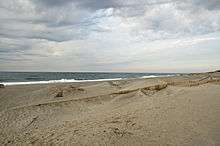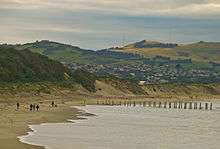Sand fence


A sand fence or sandbreak, is a type of fence that, like a snow fence, is used to force windblown, drifting sand to accumulate in a desired place. Sand fences are employed to control erosion, help sand dune stabilization, keep sand off roadways, and to recruit new material in desert areas.
A typical construction is to attach a perforated plastic sheet to stakes at regular intervals, similar to construction site fencing or temporary sports field fencing. Another is a cedar or other lightweight wood strip and wire fence, also attached to metal stakes. A permanent sand fence is generally of larger wooden poles set deeply into the ground with large wooden planks running horizontally across them.
The drifting and settling of sand behind and in front of such a fence occurs because the wind speed on both the downwind and windward sides is less than that on the far windward side, allowing light materials such as sand to settle.[1] This creates a pile both in front of and behind the sand fence causing more sand to drop out. Conveniently the sand does not drop on the barrier itself, otherwise it would soon be buried and rendered useless.[2]
See also
References
- ↑ Campbell, E. (March 1975). Snowdrift Structures. Avalanche Protection in Switzerland (pp. 103-116). Fort Collins CO: General Technical Report RM-9, USDA-Forest Service.
- ↑ How To Install Snow Sand Fence-Guidelines